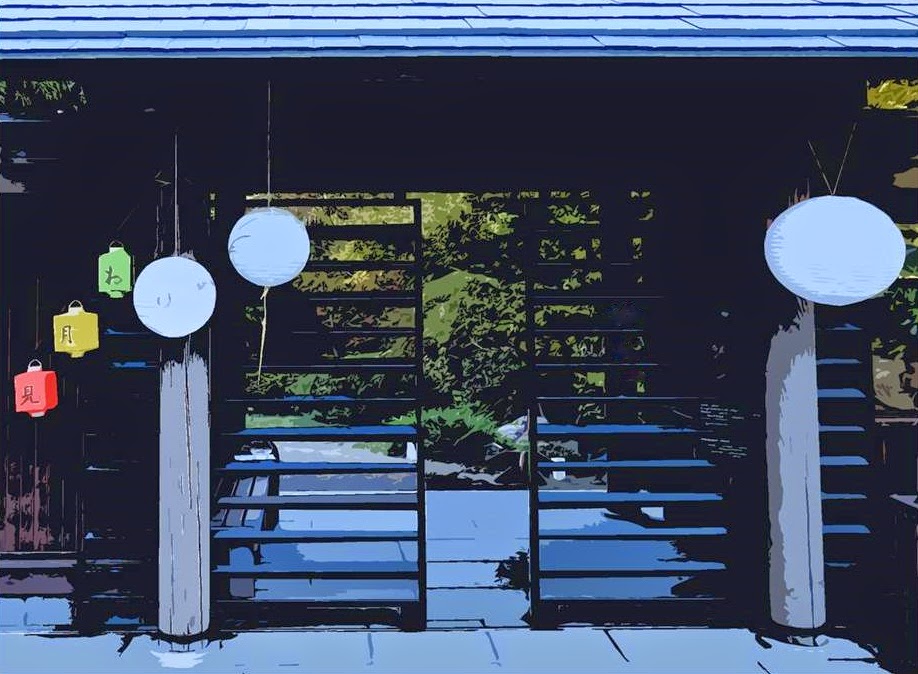by aleks
Last Thursday Robert Pacht, our fellow guide who happens to have a degree in fisheries and work experience in marine biology, treated us to a lively presentation/discussion on who lives in our pond, where did they come from and how do they survive...
 |
| Our Pond. SJG 7/24/14 |
Yeah, WHO does live down there? Up to this point, I mostly ignored the pond in my garden tours, chiefly because I had no clue on the pond life aquatic, except for the obvious koi and turtles. Koi rarely evoke inquiries while people are entertained by feeding them, and if they do, most are 'safe' question: 'how long do they live?' No, not 200 years, even if it such rubish was printed in New York Times... 'Are koi related to gold fish?' Nope, koi are carp... When we occasionally have a new school of tiny koi happily swimming around: 'Does that mean you will have hundreds of new koi soon?' Um, no, the parents or heron the fishery-manager (we call him 'Dirty Harry') will likely eat them soon...
 |
| Our turtles: NOT native, SJG 3/21/14 |
The turtles call for attention when they (poorly) compete for fish lunch cereal: 'Do they like fish food?' Apparently. Or when they appear motionlessly stacked on the rocks to sun themselves up in neat army-like formatting: 'Are they sculptures or real?' Yep, real. 'What kind of turtles are they?' Ooops: somebody told me a long time ago that they are Washington state native, and I kept repeating that fib, sometimes fortifying it with observation that they are in every lake around us (they are).
According to Robert, those turtles are as native as Himalayan blackberries here (classified as Class C noxious weeds in WA state). The red-eared slider turtles are native to the southern United States and northern Mexico, but because of irresponsible pet releases they have become an invasive species in many areas, where it outcompetes native species. The red-eared slider
(Trachemys scripta elegant, it's Polish common name is 'decorative turtle' and French 'Florida turtle') is included in the
List of the world’s 100 most invasive species in the Global Invasive Species Database! The worst of the worst and NOT native at all. As Sue put it on the subject: it's good that our tours aren't recorded....
 |
| Red-eared slider turtle, SJG 3/21/14 |
From now on I'll be better prepared to answer questions about the pond life, although I still have to pay attention, find and observe some creatures there: did you know we have crayfish? Cara says she spotted them by the stepping stones. Do you know what mollusks are? What kind of anthropods our pond hosts? Despite the fact that our pond ecosystem is a closed one the life there is incredibly rich.
Here is Robert's syllabus:
Ecology basics of our Pond, Who lives there, where did they come from, how do they survive
Ecosystem basics

What is an ecosystem ?
- Marine vs aquatic vs terrestrial
- Closed vs open
- Immigration and emigration
- Natural vs artificial
Geology and physics
- Before Lake Washington was lowered
- After 1916
- 1959 to present
- Physical forcing factors
Limnology 101
- Chemistry and primary production
- Eutrophic vs oligotrotrophic
- Phytoplankton
- Zooplankton, herbivorous and carnivorous
- Mollusks
- Arthropods
- Insects and nonplanktonic crustaceans
- Vertebrates
- Reptiles and amphibians
- Fish
- Terrestrial visitors
Self-sustaining or not? This is an interesting question Robert put forward on the end of his presentation: what would happen to the closed ecology of our pond if we, humans walked away? Think about it... And if you are as challenged as I am re: biology vocabulary, here is the
handout form the lecture - with pictures!:) (on google docs).
Thank You Robert Pacht for entertaining, informative and lively lecture! And thank you Cara, Mary Ann and Joan (did winter come to Toronto yet?)
* Crayfish gif borrowed from Mrs. Chastain's Third Grade - thank you, interesting presentation, Mrs. Chastain!













